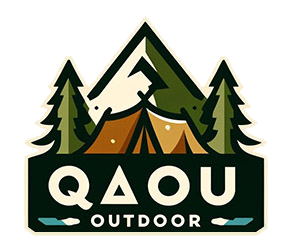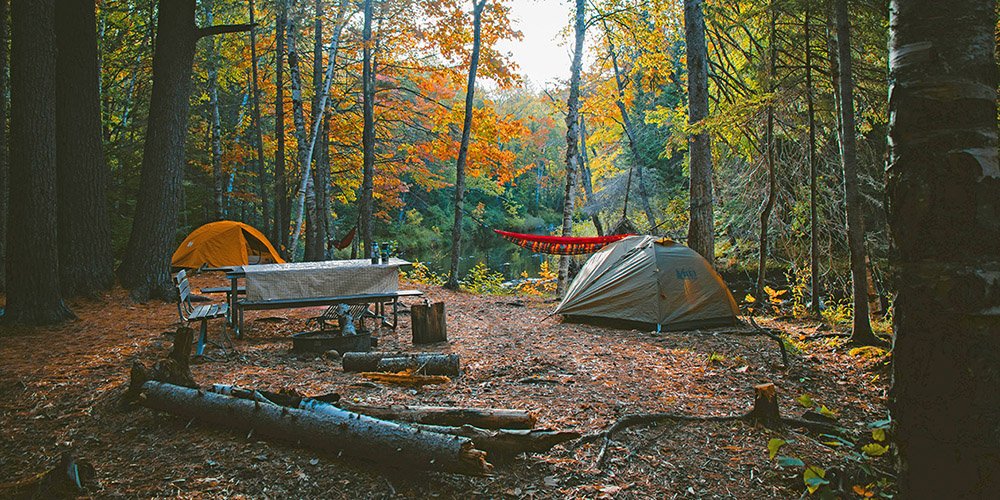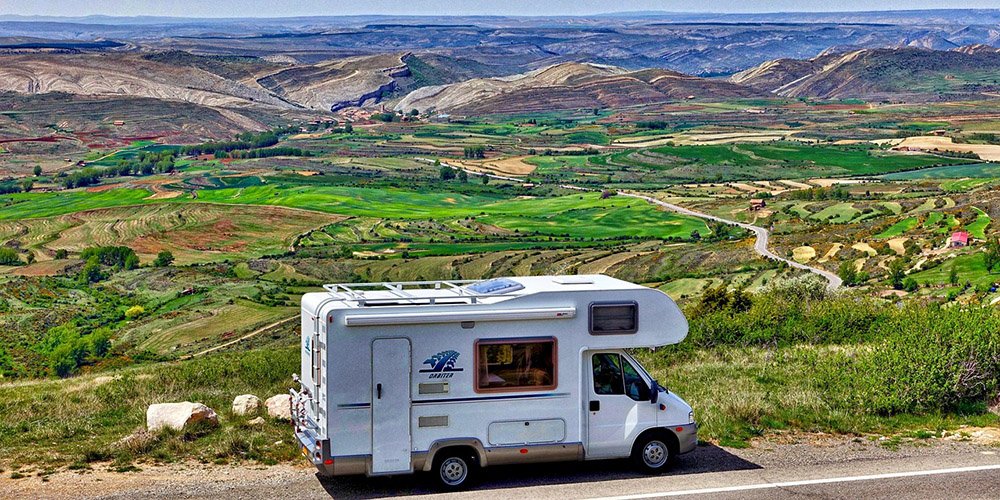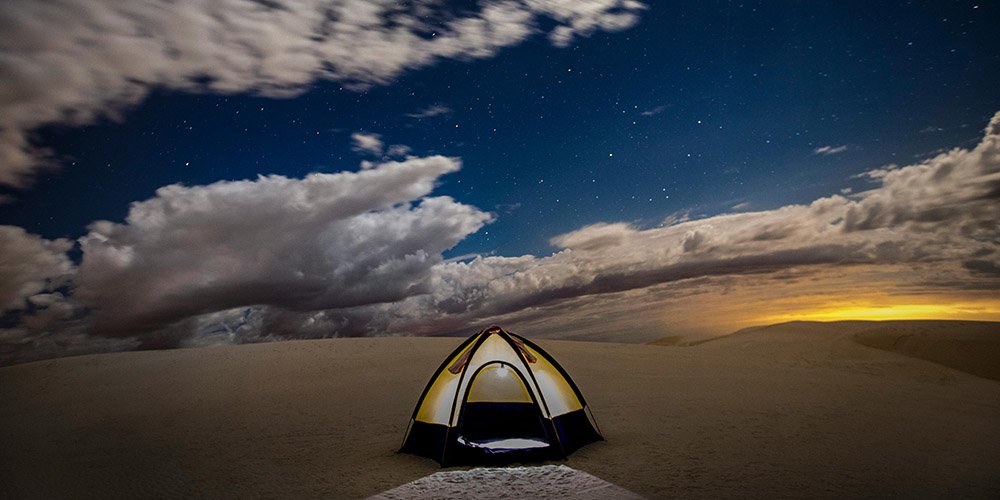Camping Setup: The Only Guide You Need
Welcome to the world of camping, where every setup can turn into a cozy, temporary home amidst the great outdoors. Whether you’re planning a solo retreat, a family adventure, or a fun group outing, the right camping setup is your key to a successful trip. In this guide, we’ll explore the essentials and some clever tricks to enhance your camping experience even if you are a beginner camper.
From selecting the perfect tent to managing your campsite with ease, we’re here to help you make the most of your outdoor adventures. Get ready to gear up with confidence and create lasting memories under the stars.
This long guide has been designed to be easy to read and avoids blocks of text, relying more on bullet-point lists, to enable you to quickly scan through them. This way, you get straight-to-the-point information that you can apply immediately. Sounds good? Let’s dive into the details and discover how you can elevate your next camping trip!
Choosing the Right Tent
When you’re gearing up for a camping trip, selecting the right tent is crucial. It’s not just about having a place to sleep; it’s about ensuring comfort, safety, and suitability for your camping environment. Here’s how to choose wisely:
Types of Tents for Different Camping Situations
- Solo Camping: A lightweight, one-person tent is ideal. Look for something compact yet comfortable, allowing for easy setup and takedown.
- Family Camping: Opt for a larger, cabin-style tent with room dividers for privacy and ample space. These tents often come with additional features like vestibules for gear storage.
- Group Camping: Large, multi-room tents with communal spaces are perfect. They offer the ability to have private sleeping areas while fostering a shared living environment.
- Backpacking: Your tent needs to be both lightweight and durable. Look for options that balance minimal weight with essential weather protection.
- Car Camping: Weight is less of a concern here; focus on comfort and space. Tents with room to stand and move around are preferred.
Advanced Tips on What to Look for in a Tent Regarding Weather Resistance and Space
- Weather Resistance:
- Fabric Quality: Invest in tents made with high-denier fabric and durable pole materials.
- Seam Taping and Waterproofing: Ensure all seams are sealed to prevent water ingress.
- Proper Ventilation: Look for adjustable ventilation options to manage condensation inside the tent.
- Space:
- Peak Height: Consider the height of the tent’s center. Higher peak heights mean more headroom and a roomier feel.
- Floor Dimensions: Check not just the square footage but also the layout. A rectangular floor plan often offers more usable space than a tapered one.
- Storage Pockets and Loops: These features help keep your interior organized and your gear off the ground.
By considering these factors, you’ll be able to choose a tent that not only fits your specific type of camping but also enhances your overall experience outdoors. Whether braving the solo trails or enjoying a bustling family campsite, your tent is your foundation for adventure.
Also read: 10 Camping Bathroom Ideas for Comfort and Convenience in the Great Outdoors
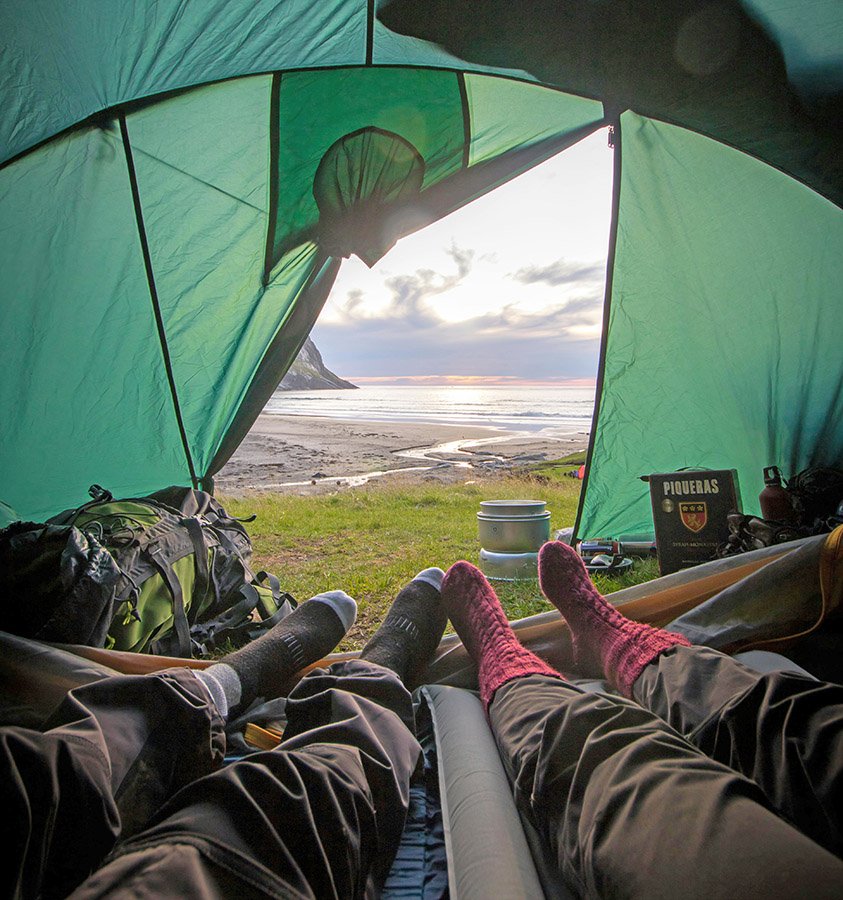
Sleeping Arrangements
A good night’s sleep is essential to enjoy your camping trip fully, and choosing the right sleeping gear is a significant part of that. Here’s a look at your options and some tips to maximize comfort:
Options for Sleeping Gear
- Sleeping Pads: These are ideal for backpackers due to their lightweight and compact design. Look for pads with a high R-value (insulation measure) to keep you warm on cold ground.
- Air Mattresses: Perfect for car camping where weight isn’t an issue. They provide excellent comfort and are closer to a traditional bed experience. Ensure you choose one with a built-in pump or bring a battery-operated pump.
- Hammocks: These are great for warm climates and are loved for their comfort and ease of setup. Ensure trees are available for anchoring, and consider a mosquito net and rainfly for protection.
Insights into Making Sleeping Outdoors as Comfortable as Possible
- Insulation is Key: Even in summer, the ground can be surprisingly cold. An insulated pad or mattress can make a significant difference.
- Layer Up: Use layers for bedding, which can be adjusted as temperatures change throughout the night.
- Choose the Right Spot: Set up your sleeping area on flat, soft ground. Avoid slopes and rocky areas to prevent discomfort and ensure a level sleeping surface.
- Consider a Sleeping Bag Liner: For extra warmth and comfort, a sleeping bag liner is a lightweight addition that can significantly enhance your sleeping experience.
- Pillow Talk: Don’t forget a small camping pillow or a pillowcase that you can stuff with clothes to support your neck properly.
With these options and tips, you can transform your night under the stars into a restful, recharging experience, no matter where your adventures take you. Remember, the right gear and a little preparation go a long way in ensuring you wake up refreshed and ready to enjoy your day outdoors.
Campsite Tools and Essentials
Every seasoned camper knows that having the right tools can make or break a camping trip. Here’s a comprehensive list of must-have tools and some DIY solutions to common camping challenges:
Must-Have Campsite Tools
- Multi-Tool: Essential for everything from repairs to meal prep.
- Headlamp and Lanterns: Vital for navigating and illuminating your campsite after dark.
- Fire Starter: Whether matches, lighters, or fire steel, always have a reliable way to start a fire.
- Rope or Paracord: Useful for everything from securing gear to hanging wet clothes.
- Tarp: Great for extra shelter from rain or sun.
- Portable Water Filter: Important for ensuring access to clean drinking water.
DIY Solutions for Common Camping Challenges
- Improvised Wind Shield for Cooking: Use a folded tarp or extra aluminum foil to shield your stove from wind, enhancing efficiency.
- DIY Lantern: Fill a jug with water and strap your headlamp around it with the light facing inward to create a makeshift lantern that diffuses light evenly.
- Gear Repair Kit: Pack duct tape, zip ties, and some sewing materials to handle unexpected gear malfunctions.
- Homemade Mosquito Repellent: Mix one part lemon eucalyptus oil with ten parts sunflower oil or witch hazel for a natural bug repellent.
Equipped with these tools and knowledge, you’ll be prepared to tackle almost any issue that arises, ensuring your camping adventure goes smoothly. Remember, the best trips are those where you can adapt and overcome any challenge with a bit of creativity and preparation!

Lighting and Electrical Needs
Proper lighting is essential for safety and convenience at the campsite. Here’s a guide to various lighting options and safety practices for using electricity outdoors:
Various Lighting Options
- Headlamps: Ideal for hands-free operation, perfect for nighttime hiking or setting up camp in the dark.
- Lanterns: Available in battery-powered, solar, or gas-powered varieties. Lanterns provide ambient light for a larger area, making them great for group activities.
- Flashlights: Essential for focused, directional light. Useful for emergency situations or when precision is needed.
Safe Practices for Using Electricity in the Outdoors
- Use Water-Resistant Products: Ensure all electrical gear is suitable for outdoor use and rated as water-resistant.
- Keep Batteries Dry: Store batteries in a waterproof container to prevent moisture damage.
- Avoid Overloading: Be mindful of the power limitations of portable generators or solar panels to prevent overloading and potential hazards.
- Proper Disposal of Batteries: Always dispose of used batteries at appropriate recycling centers to minimize environmental impact.
By choosing the right lighting options and following these safety practices, you can ensure that your campsite remains illuminated and safe, enhancing your overall camping experience.
Camp Kitchen Setups
Setting up an efficient camp kitchen can make mealtime one of the best parts of your camping trip. Here’s how to organize it and what to consider for cooking and meal planning:
Organizing Your Camp Kitchen
- Designate Areas: Separate your kitchen into cooking, cleaning, and storage areas. This keeps things organized and makes meal prep smoother.
- Portable Tables: Bring a collapsible table for prep work if your site doesn’t have a picnic table.
- Hanging Organizers: Use hanging organizers or a gear line to keep utensils and spices within easy reach.
- Modular Storage: Utilize stackable containers and modular units that can be easily rearranged depending on your needs.
- Waterproof Covers: Protect your cooking area with a waterproof tarp or canopy, especially important for unexpected weather changes.
Cooking Equipment Essentials
- Dual Fuel Stove: Consider a dual fuel stove that can use both propane and butane for versatility.
- Cast Iron Cookware: Durable and ideal for even cooking, perfect for everything from frying eggs to baking bread right at your campsite.
- Solar Oven: Explore the use of a solar oven for energy-efficient cooking during sunny trips.
Strategic Meal Planning
- Theme Nights: Plan theme meals (like taco night or BBQ night) to make each dinner something everyone looks forward to.
- Pre-Cooked Meals: Prepare some meals at home to just heat up at the campsite, saving time and reducing the need for extensive cleanup.
- Group Cooking: Assign meal days or parts of a meal to different family or group members to share the load and add variety.
Eco-Friendly Practices
- Biodegradable Soap: Opt for eco-friendly cleaning supplies for washing dishes.
- Reusable Dinnerware: Reduce waste with durable plates and utensils instead of disposable ones.
- Proper Waste Management: Always clean up thoroughly, ensuring food waste is stored securely to avoid attracting wildlife.
These enhancements to your camp kitchen will not only streamline your cooking process but also enhance your overall camping experience, making it more enjoyable and environmentally friendly.
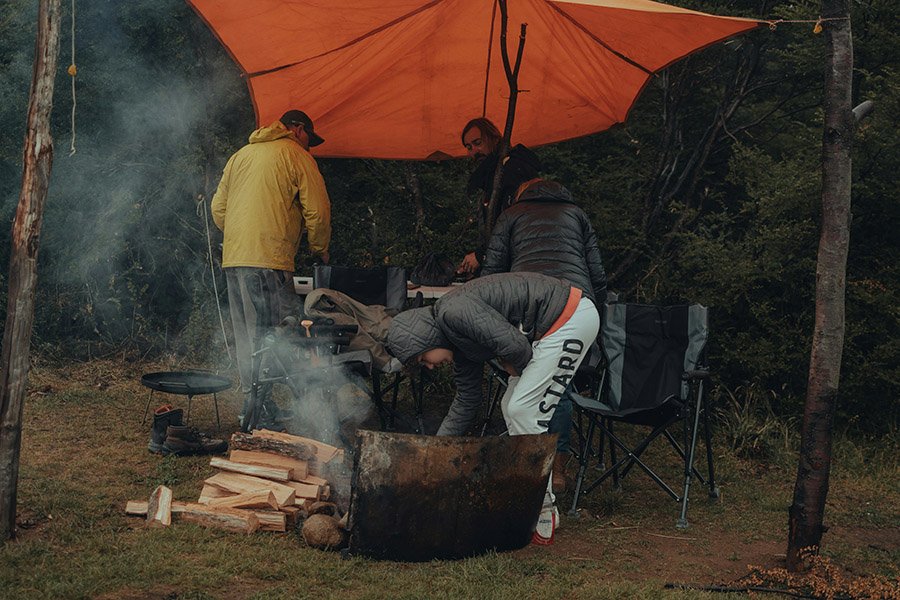
Water and Waste Management
Effective management of water and waste is essential for a sustainable and enjoyable camping experience. Here’s how to handle these aspects responsibly:
Solutions for Clean Water
- Portable Water Filters: Essential for purifying water from natural sources, ensuring it’s safe to drink.
- Water Purification Tablets: A lightweight, backup option for disinfecting water when boiling isn’t feasible.
Efficient Waste Disposal
- Leave No Trace Principles: Always pack out what you pack in, including garbage and human waste.
- Eco-Friendly Products: Use biodegradable soaps and avoid single-use plastics.
Environmental Considerations and Impacts
- Wildlife Safety: Store food and waste securely to not attract animals.
- Chemical Disposal: Never dispose of chemicals or soaps directly into water bodies; use designated disposal sites to protect ecosystems.
Implementing these practices ensures that your camping trips are environmentally friendly and that you leave your campsite as pristine as you found it.
Weather Preparedness
Properly setting up your campsite to handle various weather conditions is crucial for safety and comfort. Here’s how to be prepared:
Setting Up Your Campsite for Different Weather Conditions
- Sun and Heat: Choose shaded sites if possible, and orient your tent to minimize sun exposure. Reflective tarps can also reduce heat.
- Rain: Ensure your site is on higher ground to avoid flooding. Use waterproof tarps under and over your tent. Read our detailed guides on camping in the rain and camping in a thunderstorm.
- Wind: Secure your tent with extra stakes and guy lines. Position the narrowest part of your tent into the wind for less resistance. Read our detailed guide on camping in the wind.
- Cold: Insulate the ground with a thick tarp beneath your tent and consider a four-season tent that can withstand snow. Read our detailed guide on camping in cold weather.
Emergency Protocols and Safety Tips
- Weather Alerts: Keep a battery-powered or hand-crank weather radio to stay updated on conditions.
- Emergency Kit: Always have a kit with essentials like a whistle, flashlight, extra batteries, and emergency blankets.
- Evacuation Plan: Know the quickest route to safety and the location of the nearest shelters.
- Communication: Ensure that you have a way to communicate with the outside world, whether it’s a fully charged cell phone with a portable charger or a satellite phone in remote areas.
By preparing for various weather scenarios and knowing what to do in an emergency, you ensure that your outdoor adventures remain safe and enjoyable no matter what Mother Nature throws your way.

Activities and Entertainment
Keeping everyone entertained is key to a memorable camping experience. Here are some ideas and a packing list for both kids and adults:
Ideas for Entertainment
- Scavenger Hunts: Create a list of natural items for kids to find, turning exploration into a game.
- Storytelling: Gather around the campfire for storytelling sessions. Include ghost stories, funny anecdotes, or family memories.
- Stargazing: Use apps to identify constellations or planets, making it educational and fun.
- Outdoor Games: Bring items like frisbees, footballs, or a portable badminton set.
Packing List for Sports and Recreational Gear
- Basic Sports Kit: Include balls for soccer, basketball, or volleyball if space allows.
- Board Games and Cards: These are perfect for rainy days or quiet evenings.
- Fishing Gear: If near water, consider rods and tackle for a relaxing fishing session.
- Hiking Gear: Pack comfortable shoes, and perhaps binoculars for bird watching.
With these activities and gear, you’ll ensure that every camper, regardless of age, finds something enjoyable to do, enhancing the overall camping experience.
Safety and First Aid
Ensuring safety and preparedness with a well-stocked first aid kit and awareness of common outdoor hazards is crucial for any camping trip.
Essentials for a Camp First Aid Kit
- Basic Supplies: Bandages, antiseptic wipes, gauze, and tape.
- Medications: Pain relievers, antihistamines, and any prescription medications.
- Specialized Items: Tweezers, scissors, and a thermometer.
- Protection: Sunscreen, insect repellent, and aloe vera for burns.
Common Outdoor Hazards and How to Handle Them
- Wildlife Encounters: Keep food stored securely and know how to react if you encounter wildlife.
- Injuries: Learn basic first aid techniques like how to treat sprains, cuts, and burns.
- Getting Lost: Carry a map, compass, and GPS device. Always inform someone of your route and expected return.
With the right first aid supplies and knowledge of how to handle common hazards, you can ensure a safer and more enjoyable camping experience.

Respecting The Environment
Practicing environmental stewardship while camping is vital to preserve the natural beauty and integrity of the outdoors.
Best Practices for Leave-No-Trace Camping
- Plan Ahead and Prepare: Reduce the likelihood of resource damage by knowing the regulations and special concerns of the area you’ll visit.
- Dispose of Waste Properly: Pack out all trash, leftover food, and litter to minimize your impact.
- Minimize Campfire Impacts: Use established fire rings, keep fires small, and burn all wood to ash.
How to Camp Sustainably and Respect Wildlife
- Use Existing Campsites: Camp on durable surfaces to avoid damaging vegetation.
- Respect Wildlife: Observe wildlife from a distance, do not follow or approach them, and never feed animals.
- Be Considerate of Other Visitors: Respect other users and protect the quality of their experience.
Adopting these practices helps ensure that natural habitats are left undisturbed and remain vibrant for future generations of campers and wildlife alike.
Some Personal Tips and Tricks
Over the years of venturing into the great outdoors, I’ve gathered a collection of personal tips and tricks that have transformed my camping experiences. Here are some favorites:
Mastering the Setup: One brisk autumn evening, I learned the hard way that facing your tent door downhill can turn a rainy night into a makeshift swimming pool inside your tent. Always set up your tent on level ground and consider the direction of expected weather.
Light the Night: During a memorable trip in the Rockies, my trusty lantern gave out. Now, I always bring multiple light sources. Pack extra batteries and consider solar-powered lights which are reliable and eco-friendly.
Kitchen Conveniences: I once forgot the spatula on a family trip, and flipping pancakes with a spoon was a challenge. My tip? Create a dedicated camping kitchen box that’s always packed and ready. Include everything from spices to your favorite coffee mug.
Leave No Trace: My passion for untouched nature was ignited when I stumbled upon a pristine alpine meadow, unmarred by human activity. It reinforced my commitment to leave no trace, emphasizing packing out all trash and minimizing campfire impacts.
Stay Dry, Stay Happy: On a soggy spring outing, our campsite nearly turned into a mudslide. Since then, I always pack extra tarps—one for under the tent and one for over the common area. It’s amazing how a simple tarp setup can keep spirits high even during the heaviest downpour.
Layer Like a Pro: During a chilly night in the desert, I learned that temperatures can plummet unexpectedly. Now, I always dress in layers. This approach lets you adjust to varying temperatures throughout the day and night without overpacking.
Secure Your Food: A curious raccoon once made off with our trail mix while we slept. Now, I use airtight containers and a hanging bear bag when in bear country. This not only protects our food but also keeps the local wildlife safe from human snacks.
Document Your Journey: After losing a camera on a canoe trip, I started backing up photos nightly on a portable drive. It’s also fun to keep a journal. Documenting your adventures enriches memories and lets you share practical insights with fellow camping enthusiasts.

Tips for Solo Camping Setup
Solo camping offers a unique blend of solitude and adventure. Here are some tips to make it safe and enjoyable:
- Pack Light, Pack Right: Choose lightweight and multipurpose gear to minimize your load without compromising on essentials.
- Safety First: Share your itinerary with someone back home and carry a GPS tracker or emergency beacon.
- Efficient Shelter: A one-person tent or hammock is ideal for solo campers. They’re easy to set up and take down, and provide comfort without excess space.
- Meal Simplicity: Opt for simple, no-cook meals or a small, efficient stove for hot food. This reduces prep time and pack weight.
Tips for Camping Setup for Families
Camping with family can create cherished memories. Here are tips to ensure everyone from toddlers to grandparents has a great time:
- Spacious Shelter: Choose a tent with enough room to comfortably accommodate everyone and their gear. Consider tents with separate rooms for privacy.
- Engage Everyone: Involve kids in the camping process, from setting up the tent to cooking meals. It’s a great learning experience and keeps everyone engaged.
- Comfort Matters: Bring along comfort items like favorite pillows, toys for kids, and extra padding for sleeping arrangements.
- Plan Activities: Have a mix of planned activities and free time. This keeps the family entertained and allows everyone to explore at their own pace.
Final Thoughts
As we wrap up this comprehensive guide on camping setups, remember that each piece of advice and every tip shared comes from a place of passion and experience. Whether you’re embarking on a solo journey, venturing into the wild with friends, or making memories with your family, the right setup can turn a good camping trip into a great one.
Always prepare for the unexpected and embrace the beauty of nature. Happy camping, and may each trip bring you closer to the great outdoors and the adventures that await!
